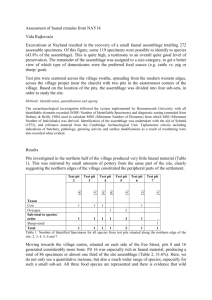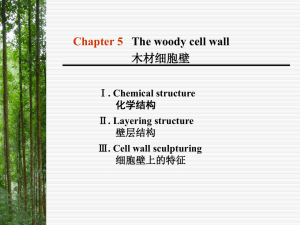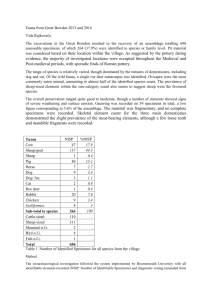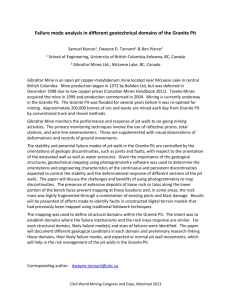Faunal remains from Sudbury 2014 Vida Rajkovača Excavations in
advertisement
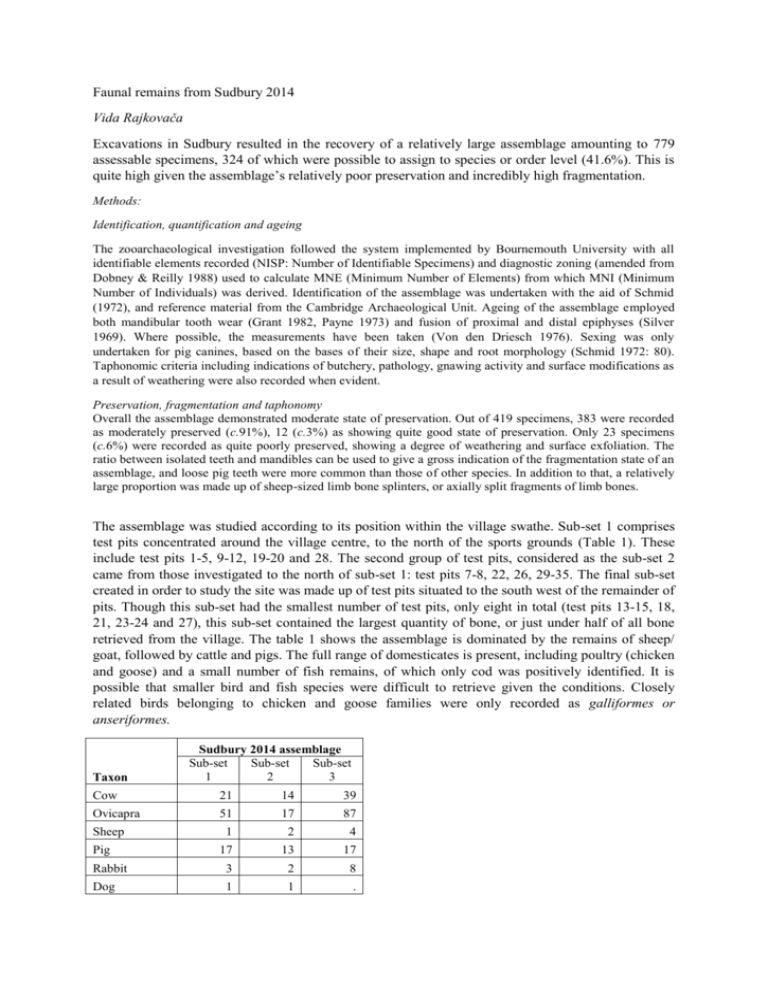
Faunal remains from Sudbury 2014 Vida Rajkovača Excavations in Sudbury resulted in the recovery of a relatively large assemblage amounting to 779 assessable specimens, 324 of which were possible to assign to species or order level (41.6%). This is quite high given the assemblage’s relatively poor preservation and incredibly high fragmentation. Methods: Identification, quantification and ageing The zooarchaeological investigation followed the system implemented by Bournemouth University with all identifiable elements recorded (NISP: Number of Identifiable Specimens) and diagnostic zoning (amended from Dobney & Reilly 1988) used to calculate MNE (Minimum Number of Elements) from which MNI (Minimum Number of Individuals) was derived. Identification of the assemblage was undertaken with the aid of Schmid (1972), and reference material from the Cambridge Archaeological Unit. Ageing of the assemblage employed both mandibular tooth wear (Grant 1982, Payne 1973) and fusion of proximal and distal epiphyses (Silver 1969). Where possible, the measurements have been taken (Von den Driesch 1976). Sexing was only undertaken for pig canines, based on the bases of their size, shape and root morphology (Schmid 1972: 80). Taphonomic criteria including indications of butchery, pathology, gnawing activity and surface modifications as a result of weathering were also recorded when evident. Preservation, fragmentation and taphonomy Overall the assemblage demonstrated moderate state of preservation. Out of 419 specimens, 383 were recorded as moderately preserved (c.91%), 12 (c.3%) as showing quite good state of preservation. Only 23 specimens (c.6%) were recorded as quite poorly preserved, showing a degree of weathering and surface exfoliation. The ratio between isolated teeth and mandibles can be used to give a gross indication of the fragmentation state of an assemblage, and loose pig teeth were more common than those of other species. In addition to that, a relatively large proportion was made up of sheep-sized limb bone splinters, or axially split fragments of limb bones. The assemblage was studied according to its position within the village swathe. Sub-set 1 comprises test pits concentrated around the village centre, to the north of the sports grounds (Table 1). These include test pits 1-5, 9-12, 19-20 and 28. The second group of test pits, considered as the sub-set 2 came from those investigated to the north of sub-set 1: test pits 7-8, 22, 26, 29-35. The final sub-set created in order to study the site was made up of test pits situated to the south west of the remainder of pits. Though this sub-set had the smallest number of test pits, only eight in total (test pits 13-15, 18, 21, 23-24 and 27), this sub-set contained the largest quantity of bone, or just under half of all bone retrieved from the village. The table 1 shows the assemblage is dominated by the remains of sheep/ goat, followed by cattle and pigs. The full range of domesticates is present, including poultry (chicken and goose) and a small number of fish remains, of which only cod was positively identified. It is possible that smaller bird and fish species were difficult to retrieve given the conditions. Closely related birds belonging to chicken and goose families were only recorded as galliformes or anseriformes. Taxon Sudbury 2014 assemblage Sub-set Sub-set Sub-set 1 2 3 Cow 21 14 39 Ovicapra 51 17 87 1 2 4 17 13 17 Rabbit 3 2 8 Dog 1 1 . Sheep Pig Dog/ fox 1 . . Cat . . 2 Weasel/ stoat 1 . . Chicken Domestic goose 4 4 4 . . 2 Galliformes 3 . . Anseriformes . 1 1 Cod . 1 2 Sub-total to species/ order 103 55 166 Cattle-sized 34 30 62 Sheep-sized 114 79 114 Rodent-sized . . 1 Mammal n.f.i. 1 1 1 Bird n.f.i. 7 1 8 Fish n.f.i. 1 . 1 260 166 353 Total Table 1. Number of Identified Specimens for all species from all sub-sets from Sudbury (2014); the abbreviation ‘n.f.i.’ denotes that the specimen could not be further identified. Sub-set one: test pits 1-5, 9-12, 19-20 and 28 The first three pits contained relatively small amounts of bone, though almost all contexts contained a few fragments, mostly unidentifiable limb shaft splinters. Reflecting the overall importance of sheep/ goat in the assemblage, ovicapra were dominant within this sub-set (Tables 2-6). A small fragment of a mandible was also recorded belonging to either weasel or stoat. Butchery was rare, noted on a small number of specimens (ten or 3.8% of the sub-set). Taxon Cow Ovicapra Pig Dog Rabbit Weasel/ stoat Sub-total to species/ order Cattle-sized Sheep-sized Total Test pit 1 [3] [4] [5] . . . . . 1 . 1 . . . . . 1 . . . . . . 3 3 2 . 1 3 1 1 1 3 [1] . 1 1 . . . [2] 1 1 . 1 . . 2 . 1 3 3 . 3 6 Test pit 2 [3] [4] [5] 1 . . . . . . . . . . . . . . 1 . . 2 2 4 8 . . 2 2 . . 3 3 [6] 1 1 . . . . [7] . . . . . . [1] . 1 . . . . 2 . . 2 . 1 1 2 1 3 1 5 Test pit 3 [2] [3] [4] . . . . 2 . 1 . . . . . . . . . . . 1 1 . 2 2 . 3 5 . . 3 3 Table 2. Number of Identified Specimens for all species from test pits 1, 2 and 3. Test pits 4 and 5 generated considerably bigger quantity of bone, though only a small percentage was identifiable to species. Taxon Cow [2] . [3] . [4] . Test pit 4 [6] [7] [8] . . . [9] . [10] . [11] 1 [2] . [5] . Test pit 5 [6] [7] [8] . . . [9] . [10] . Ovicapra Sheep Pig Chicken Sub-total to species/ order Cattle-sized Sheep-sized Total . . . . . . . . . . . . 5 . . . . . . . . . . . 1 . . . . . . . . . . . . . 1 . . . . . 1 . . . 3 . . . 3 . . . 2 1 . . 1 . 1 2 . . 1 1 . 1 . 1 . . 2 2 5 1 2 8 . . 4 4 . 1 2 3 1 . 2 3 . 1 . 1 1 1 . 2 1 2 . 3 . . 5 5 1 . 1 2 3 . 4 7 3 . 9 12 3 . 3 6 4 . 1 5 Table 3. Number of Identified Specimens for all species from test pits 4 and 5. Test pits 9, 10, 11 and 12 contained a small amount of bone, with cow and pig turning up in bigger numbers. Test pits 19 and 20 also did not produce any significant amounts of fauna. Test pit 28 generated bone from all contexts. [2] Taxon Cow Ovicapra Pig Chicken Galliformes Sub-total to species/ order Cattle-sized Sheep-sized Bird n.f.i. Total 1 . 1 . 1 3 . 3 1 7 Test pit 9 [3] [4] [5] . 1 . 1 . . 2 1 1 . . . . . . 3 1 2 . 6 2 1 3 . 6 1 2 1 . 4 [6] . . . . . [7] 1 . . . . [2] . 1 . . . . . 2 . 2 1 . 2 . 3 1 . 1 . 2 Test pit 10 [3] [4] [5] . 2 2 1 . 5 1 . 1 . 1 . . . . 2 . . . 2 3 1 3 . 7 8 . . . 8 [1] . 1 . . . Test pit 11 [3] [5] [6] 1 1 4 . 3 1 . 1 . 1 . . 1 . . 1 . . . 1 3 . 1 3 7 Table 4. Number of Identified Specimens for all species from test pits 9, 10, 11 and 12. Taxon Cow Ovicapra Pig Rabbit Dog/ fox Galliformes Sub-total to species/ order Cattle-sized Sheep-sized Total [1] . . . . . . [2] . 2 . . . 1 . 1 . 1 3 . 1 4 Test pit 19 [3] [4] [5] 2 1 . . 3 1 . 1 . 1 . . 1 . . . . . 4 1 1 6 5 1 4 10 [8] . 2 . . . . 1 1 . 2 Test pit 20 [2] . 2 . . . . 2 . . 2 2 . 1 3 Table 5. Number of Identified Specimens for all species from test pits 19 and 20. Taxon Cow Ovicapra Pig Rabbit Sub-total to species/ order [1] . . . . [2] . . . 1 [3] . . 1 . [4] . . 1 . [5] . . 1 . . 1 1 1 1 Test pit 28 [6] [7] [9] 1 . . 1 1 1 . . . . . . 2 1 1 [10] . 1 . . [11] . . 1 . [12] 1 . . . 1 1 1 5 1 3 . 9 5 4 6 . 15 Test pit 12 [4] [6] . . . . . . . . . . . . 1 . 1 . 1 1 . 2 Cattle-sized Sheep-sized Mammal n.f.i. Bird n.f.i. Fish n.f.i. Total . 3 . 2 . 3 . 1 . . 2 . . 1 1 4 . . 1 . . . . 1 . 4 . 1 1 5 . . . 4 1 . . 3 . . . 1 . . . 4 . . . 2 . . . 6 . 1 . 2 . . . 2 . . . 1 Table 6. Number of Identified Specimens for all species from test pit 28. Some of the test pits excavated within this sub-set contained somewhat more, better preserved bone in later contexts. Sub-set two: test pits 7-8, 22, 26, 29-35 In quantitative terms, the smallest of the three sub-sets yielded a similar range of species to those recovered from the remainder of the assemblage (Tables 7-11). Following the same pattern, sheep/ goat and cattle dominated, though the majority of bone was only possible to assign to a size-category. Typically, contexts generating a wide range of pottery dates also produced slightly more animal bone compared to the others. Taxon Cow Ovicapra Sheep Pig Chicken Dog Sub-total to species/ order Cattle-sized Sheep-sized Bird n.f.i. Total [1] . . . . . . [2] 3 2 . . . . [3] . . . . 1 . . . 3 . 3 5 . 1 . 6 1 1 2 . 4 Test pit 7 [4] [5] [6] . . . . 1 . . . . . . 1 1 . . . . . 1 . 2 . 3 1 . 1 . 2 [7] . . . . . . [8] . 1 . . . . . . . 1 1 1 1 . . 2 1 . . . 1 Test pit 8 [2] [3] [4] . . 2 . . 1 . 2 . . . . . . . 1 . . 1 . . . 1 2 4 1 . 7 3 . . . 3 Table 7. Number of Identified Specimens for all species from test pits 7 and 8. Taxon Cow Ovicapra Pig Rabbit Sub-total to species/ order Cattle-sized Sheep-sized Total [2] . 1 . . Test pit 22 [3] [4] . . 2 1 . . . 2 1 . 1 2 2 . 3 5 . . 1 . . . . . Test pit 26 [5] [6] . . . . 1 1 . . 1 4 5 10 1 . 1 1 . 1 2 [5] 3 1 1 5 [8] Table 8. Number of Identified Specimens for all species from test pits 22 and 26. Taxon Pig [1] . Test pit 29 [2] [3] 1 1 [4] . [2] . Test pit 30 [3] [4] . . [5] . 1 2 1 4 Sub-total to species/ order Cattle-sized Sheep-sized Mammal n.f.i. Total . . 4 . 4 1 2 1 . 4 1 2 . . 3 . . 2 . 2 . 1 . . 1 . 1 1 . 2 . . 2 1 3 . . 4 . 4 Table 9. Number of Identified Specimens for all species from test pits 29 and 30. Taxon Cow Ovicapra Chicken Sub-total to species/ order Cattle-sized Sheep-sized Total [2] 1 . . [3] . . 1 1 . 2 3 1 . 3 4 Test pit 31 [5] [6] [7] . . . 1 . 1 . . . 1 1 5 7 . 1 1 2 1 . 1 2 [8] . . . [4] . . . . . 1 1 . . 6 6 Test pit 32 [5] [6] [7] . . . . . . . . . . . 2 2 . . 1 1 . . 2 2 [8] 1 . . 1 1 . 2 Table 10. Number of Identified Specimens for all species from test pits 31 and 32. Taxon Cow Ovicapra Pig Chicken Domestic goose Cod Sub-total to species/ order Cattle-sized Sheep-sized Total [2] . . . . . . [3] . . 1 . . . . . 2 2 1 . 2 3 Test pit 33 [5] [6] [7] 1 . 1 . 2 . . . . . . . . . . . 1 . 1 1 1 3 3 1 1 5 1 . . 1 [9] . 1 1 . . . [3] . . 1 . . . [4] . . . . . . 2 1 1 4 1 . 1 2 . 1 6 7 Test pit 34 [5] [6] [8] 3 1 . 1 1 1 . 2 1 1 . . . 1 . . . . 5 1 2 8 5 . . 5 2 1 . 3 [9] . . . . . . Test pit 35 [2] . 1 . 1 . . . . . . . . 3 3 Table 11. Number of Identified Specimens for all species from test pits 33, 34 and 35. Sub-set three: test pits 13-15, 18, 21, 23-24 and 27 Though coming from the smallest number of different test pits, this assemblage generated almost half of the entire assemblage (Tables 2, 12-15; 353 assessable specimens, 45.3%). Test pit 14 was especially rich in animal bone and the range of species was somewhat different with sheep being present in large numbers and ducks being recorded for the first time. Butchery was noted on 18 specimens (c.5% of the sub-set) and sawing was the most commonly observed action. An interesting, yet common mark was noted on cow scapula: trimming of the origin of spina and a perforation in the scapula blade. This is consistent with meat curing, and trimming of spina suggests scapulae were submerged in brine. The practice of meat curing and preparing beef joints in this manner is commonly believed to be an indicator of a Romano-British date, though cow scapulae with perforations are now recorded from almost all periods. Other points of interest include a cow metacarpus had osteochondritis dissecans in the proximal articulate surface, a condition which appears as lesions – a result of stress to the joint. Remains of neonate and older individuals were recorded for cattle and sheep respectively, suggesting animals were reared on site, or in the vicinity. Taxon Cow Test pit 13 [2] [3] [4] . . 1 [1] . [2] . [3] 2 Test pit 14 [4] [5] [6] 1 2 5 [7] 3 [8] . Ovicapra Sheep Pig Rabbit Cat Anseriformes Sub-total to species/ order Cattle-sized Sheep-sized Bird n.f.i. Total . . . . . . 1 . . . . . . . . . . . 1 . . . . . . . . . . . 2 . . 2 1 1 6 . 1 . . . 11 . 1 . . . 19 1 1 . . . 3 2 . . . . 1 . . . . . . 2 . . 2 1 . 2 . 3 1 3 1 . 5 1 1 1 . 3 . 4 . 4 8 1 . 4 13 8 3 . . 11 14 3 3 . 20 26 3 . . 29 8 . 3 . 11 1 . 4 . 5 Test pit 12. Number of Identified Specimens for all species from test pits 13 and 14. Taxon Cow Ovicapra Pig Chicken Domestic goose Cod Sub-total to species/ order Cattle-sized Sheep-sized Bird n.f.i. Fish n.f.i. Total [2] 1 . . . . . [3] . 2 . . . . [4] 3 5 3 . . . Test pit 15 [5] [6] [7] 2 1 . 3 7 . 1 2 1 . . . 2 . . . . . 1 . 2 . . 3 2 . 1 . . 3 11 6 6 . . 23 8 1 9 1 . 19 10 4 10 . . 24 1 6 7 . . 14 [8] 4 5 . . . 1 [9] 2 2 1 . . . [10] 4 2 . 1 . . 10 10 7 1 1 29 5 4 5 . . 14 7 4 8 . . 19 Test pit 13. Number of Identified Specimens for all species from test pits 15. Taxon Cow Ovicapra Sheep Pig Rabbit Cod Sub-total to species/ order Cattle-sized Sheep-sized Mammal n.f.i. Bird n.f.i. Total Test pit 18 [4] [5] [6] 2 2 1 . 2 2 . . . 1 1 2 1 . . . . 1 [1] . . . . . . [2] . . . . 2 . [3] . . . . . . . . 2 2 . 1 . 1 4 1 . 5 . 4 . . 2 . . 3 . . 1 . . 5 . . 9 Test pit 21 [3] [6] [7] . . 1 2 . . . 1 . . . . . . . . . . [7] . 2 . . . . [8] . 2 . . . . [2] . . . . . . [9] . 1 . 1 . . 6 . 4 2 . 3 2 1 4 . . . 2 . . 1 . . 1 3 2 2 . 1 . . 10 . . 5 . . 7 1 . 1 . . 2 . . 1 . . 6 . 1 4 Test pit 14. Number of Identified Specimens for all species from test pits 18 and 21. Taxon Cow [1] . Test pit 23 [2] [3] [4] . . . [5] . [1] . [2] . Test pit 24 [3] [6] [8] 1 . 1 [9] . [1] . Test pit 27 [2] [4] [6] . . . [7] . Ovicapra Pig Rabbit Chicken Cat Sub-total to species/ order Cattle-sized Sheep-sized Rodentsized Bird n.f.i. Total 1 . 1 . . 1 . . . . . . . . . 1 . . 1 . . . 1 . . . . . . . . . . 1 . 1 . . . . . 1 . . . . . . . . . . . . . 1 . . . . 1 . 1 1 . . . . . . . . . . 1 . . . . . 2 . 2 1 1 4 . . 3 2 . 1 1 . 3 . . 1 1 1 1 2 . 1 1 . . 1 . . . . 1 1 . . 3 1 . . . 1 1 . 1 . 3 . . . 4 . . 6 . 1 4 1 . 4 . . 4 . . 1 . . 3 . . 3 . . 1 . . 1 . . 1 . . 1 . . 4 . . 1 . . 2 . . 3 Test pit 15. Number of Identified Specimens for all species from test pits 23, 24 and 27. The rich faunal record recorded from these test pits suggests intensive and continuous activity in the village proper. Pottery dates indicated the site was occupied during the Saxon and Norman periods, and the use continued until the Victorian period. Typically, those contexts of Saxon date always contain sheep/ goat as a dominant component, and Victorian contexts contained bone which was heavily processed. The same test pits generated large quantities of bone and pottery, a clear indication of a concentrated and continued occupation of the site. It is hard to discuss the economic patterns or husbandry with the lack of ageing data, though butchery is a good indicator of food processing. The most common action was sawing, and this is unsurprising, given that saw became the multipurpose tool in later periods, used for a range of actions. Sheep and cattle vertebra were often sawn down the sagittal plane, and this is indicative of carcasses which were hung and split into left and right portions. This butchery action became especially popular in the 15 th and 16th century, though it has been recorded in prehistory. The dominance of livestock species is another typical pattern, suggesting an overall reliance on domestic sources of food. Teeth were as common as joints of high meat value, an indication the population raised their own animals, though some meat may have been imported as dressed joints. Bibliography: Dobney, K., and Reilly, K., 1988. A method for recording archaeological animal bones: the use of diagnostic zones, Circaea 5 (2): 79-96. Grant A. 1982. The use of tooth wear as a guide to the age of domestic animals, in B. Wilson, C. Grigson and S. Payne, (eds.), Ageing and sexing animal bones from archaeological sites. Hillson, S., 1999. Mammal Bones and Teeth: An introductory Guide to Methods of Identification. University College of London: Institute for Archaeology Payne, S. 1973 ‘Kill-off patterns in sheep and goats: the mandibles from Asvan Kale’, Anatolian Studies 23, pp.281-303. Schmid, E. 1972. Atlas of animal bones. Amsterdam: Elsevier. Silver I. A., 1969. The ageing of domestic animals, in D. Brothwell and E. Higgs E. S. (eds.), Science in archaeology, 2nd edition: 283-301. London: Thames and Hudson. Von den Driesch, A. 1976. A guide to the measurement of animal bones from archaeological sites, Peabody Museum Bulletin 1. Cambridge Mass., Harvard University.
